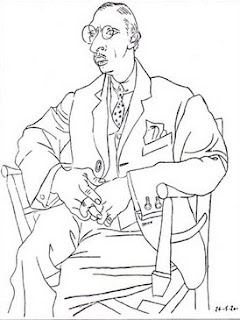 |
| Designed by Tim O. |
Tuesday, February 11, 2014
Working with Text & Shapes
Designing for the Web
In this lesson you will create 5 different images that show your knowledge of use selection tools, filters, color, shapes and texts. One image should show use of the crop tool and your previous portraits. Pay attention to the negative space in your work to find a place where you can add these elements. We are trying to create depth and interest in our piece. The "f/x" tool will help you design and personalize your text. See the full description of the lesson below.
Contour Drawing
Intro to Drawing
Last week in class we warmed up to drawing again by doing several gesture drawings. The quick lines that we drew are quite the opposite of what we will be doing when we are creating contour drawings. We will look carefully at the edges of our subject and draw slowly.
Mona Brookes, author of Drawing for Older Children and Teens, writes:
"By following what appears to be the outline edges of an object, you can create an impression of it. Contour Drawing is a style of realistic drawing, but it doesn't capture the kind of three-dimensionality that you can achieve with shading."
Below notice the way Pablo Picasso uses a line to represent most of the edges of the figure below. He tried to keep the correct proportions and successfully portrays the physical characteristics of the model. Learning how to create contour drawings is a fundamental skill that all artists should develop.
We will also try a couple Blind Contour drawings. This is when you draw using one continuous line and do not look at your paper.
Sketchbook Assignment: Draw 5 contour drawings of your hand and for Extra Credit draw 3 contour drawings of your foot. Due 2/19
Last week in class we warmed up to drawing again by doing several gesture drawings. The quick lines that we drew are quite the opposite of what we will be doing when we are creating contour drawings. We will look carefully at the edges of our subject and draw slowly.
Mona Brookes, author of Drawing for Older Children and Teens, writes:
"By following what appears to be the outline edges of an object, you can create an impression of it. Contour Drawing is a style of realistic drawing, but it doesn't capture the kind of three-dimensionality that you can achieve with shading."
Below notice the way Pablo Picasso uses a line to represent most of the edges of the figure below. He tried to keep the correct proportions and successfully portrays the physical characteristics of the model. Learning how to create contour drawings is a fundamental skill that all artists should develop.
We will also try a couple Blind Contour drawings. This is when you draw using one continuous line and do not look at your paper.
Class assignment: Draw a contour drawing of the vase will flowers. Try very hard to just draw edges with a line. Do not shade in at all! Think about the negative and positive space on your paper. As yourself where you are going to place the bottom of the vase on your paper so you still have room for the top of the flower. Think about proportions (the size relationships of the parts of the flower and the vase).
Sketchbook Assignment: Draw 5 contour drawings of your hand and for Extra Credit draw 3 contour drawings of your foot. Due 2/19
 |
| Contour Drawing |
 |
| Outline |
Sunday, February 9, 2014
Sky, Land, COLOR
Advanced Drawing and Painting
"Each of these
luminous and mysterious images of trees against sky, field, and river evoke a
subtle variation of light and atmosphere. The arrangement of the trees -
whether standing in solitude or in pairs or in large groupings seem at once inevitable
and yet surprising, formal yet accidental. All of these paintings are comprised
from memory, imagination and thumbnail sketches from my beautiful basement
studio in my home in Connecticut. I work on wood board, paper and canvas using
several layers of gesso before priming the surface with cadmium red base, a
quick sketch using charcoal is used to lay out the design then the paint is
applied. I work in layers using thinned down oil color, building on these
layers with glazing techniques the colors are adjusted and brought up to
completion before final coats of varnish are applied. Light has come to play an
important part, and when I look back over this body of work, I feel it speaks
about spiritual places, places that contain a quiet inner light, radiating an
ethereal whisper, the places we see every day."
- William McCarthy
Your next assignment is to create an acrylic
landscape that experiments with the layering of color to create a luminous
atmosphere. William McCarthy takes photographs and draws thumbnail sketches of landscapes that have an
appealing composition or beautiful lighting. He then goes back to the studio and creates a landscape that may or may
not be representational. Some artists
would prefer only to paint outside looking at the natural world and how the sun
affects it, there are many ways to create a landscape or seascape. You can be inspired by a sunset, but not want to duplicate it. There is no right or wrong way to approach drawing a natural setting it would be ideal to pause the perfect sunset so you can paint what you are seeing, but you can't.
For this project focus on:
For this project focus on:
- · Creating a composition that has at least 60 percent sky so the horizon line falls below the center of your piece. This will allow you to focus on creating an interesting sky and you can layer colors in larger areas.
- · Choose a color scheme that includes tints with accents of other more intense colors.
- · Search for a landscape or seascape that inspires you, but that you aren’t “copying”. You can use a photograph you or someone you know took. You wont be duplicating them, but observing the colors, shapes, texture of the sky. You can also combine images from a variety of photographs to create the one you like.
- · Abstract if you like. This painting could be a very abstract one with barely any details if you choose, but you need to have a beginning reference.
Subscribe to:
Comments (Atom)



.jpg)




